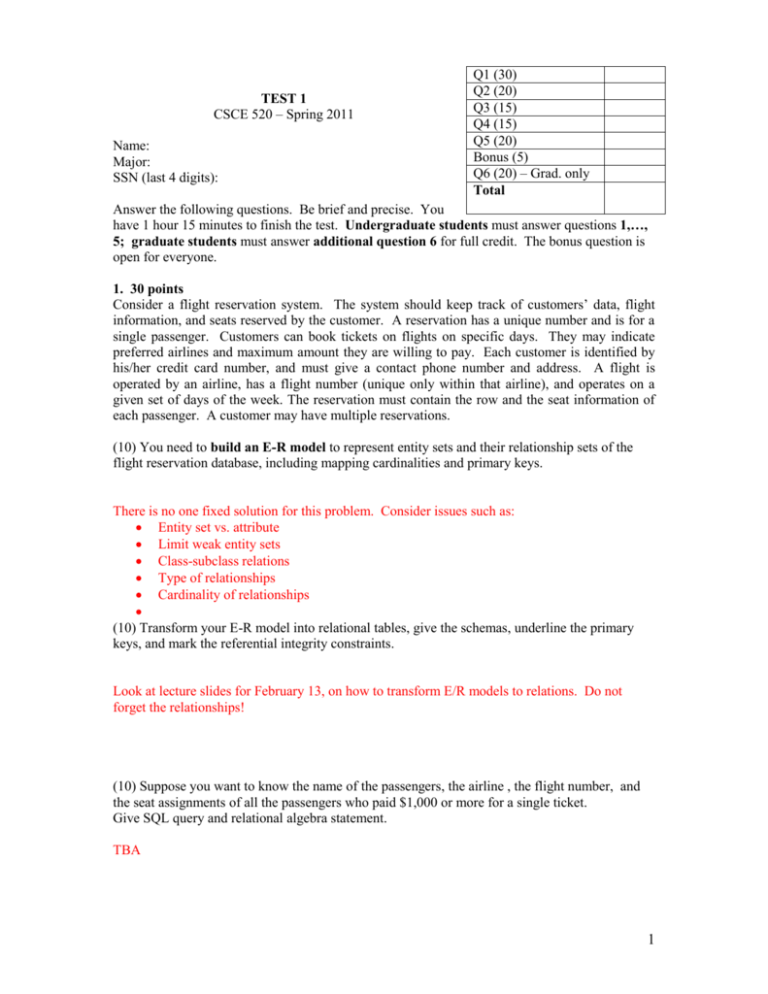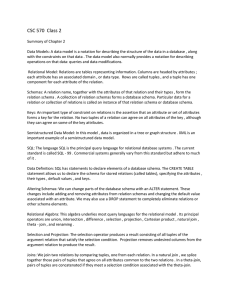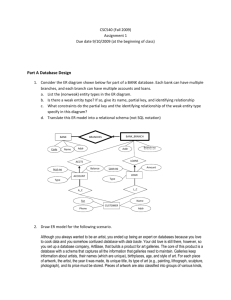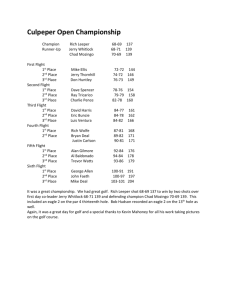solution
advertisement

TEST 1 CSCE 520 – Spring 2011 Name: Major: SSN (last 4 digits): Q1 (30) Q2 (20) Q3 (15) Q4 (15) Q5 (20) Bonus (5) Q6 (20) – Grad. only Total Answer the following questions. Be brief and precise. You have 1 hour 15 minutes to finish the test. Undergraduate students must answer questions 1,…, 5; graduate students must answer additional question 6 for full credit. The bonus question is open for everyone. 1. 30 points Consider a flight reservation system. The system should keep track of customers’ data, flight information, and seats reserved by the customer. A reservation has a unique number and is for a single passenger. Customers can book tickets on flights on specific days. They may indicate preferred airlines and maximum amount they are willing to pay. Each customer is identified by his/her credit card number, and must give a contact phone number and address. A flight is operated by an airline, has a flight number (unique only within that airline), and operates on a given set of days of the week. The reservation must contain the row and the seat information of each passenger. A customer may have multiple reservations. (10) You need to build an E-R model to represent entity sets and their relationship sets of the flight reservation database, including mapping cardinalities and primary keys. There is no one fixed solution for this problem. Consider issues such as: Entity set vs. attribute Limit weak entity sets Class-subclass relations Type of relationships Cardinality of relationships (10) Transform your E-R model into relational tables, give the schemas, underline the primary keys, and mark the referential integrity constraints. Look at lecture slides for February 13, on how to transform E/R models to relations. Do not forget the relationships! (10) Suppose you want to know the name of the passengers, the airline , the flight number, and the seat assignments of all the passengers who paid $1,000 or more for a single ticket. Give SQL query and relational algebra statement. TBA 1 2. 20 points (10) Describe how you can express constraints using relational algebra. Page 59 in Ullman & Widom 2.5.1. Either way is acceptable Consider the Classes relation with the following schema: Classes(class, type, country, numGuns, bore, displacement) (5) Write the relational algebra expression to ensure that no class of ships may have guns with larger than 16-inch bore. bore>16 (Classes) = (5) How can you enforce the same constraints using SQL? During CREATE TABLE statement: CREATE TABLE Classes ( … Bore INT , … CHECK (Bore <=16) ); 3. 15 points Describe the characteristics of relations that make them different from ordinary tables and files. Multiple characteristics exist, such as: Structure Granularity and efficiency of data access Semantics of stored data Support for consistency and persistent storage Support for concurrency Etc. 2 4. 15 points Consider the flight reservation system you have designed for Question 1. Describe the security issues related to the database. Assume that the database is used by the following three types of users: manager, customer representatives, and customers. Describe the access control restrictions for each group of users. You can describe the security requirements organized according to the 3 security objectives: Integrity, confidentiality, and availability For example: Integrity: it is required that the customers’ information is correct, including the customers’ personal and financial data as well as their reservation information. Confidentiality: customers’ private information should be protected, such as flight information, etc. Moreover, confidential data, such as credit card information, should be kept in a secure manner. Availability: Information about the customers’ flights should be available when needed. You can further tailor these requirements based on the type of user accessing the data. For example, managers should be permitted to modify customers’ data, and ticket pricing. Customer representatives should be permitted to modify customers’ reservations, issue tickets, etc. Customers should have read-only access to all of their own data but no one else’s. 5. 20 points (5) Describe the difference between natural join and theta-join when the condition of the theta join is to equate the attributes appearing in the schemas of both relations. Schema Number of Tuples Control of join Natural join All attributes of the relations With single occurrence of the Overlapping attributes Theta-join All attributes of the relations with multiple occurrence of the overlapping attributes Joins only those tuples that have the same values for overlapping Attributes Automatically for shared attributes joins all tuples and chooses those that satisfy the selection cond. Cartasian product Consider relations R(A, B, C) with n tuples, and relation S(C,D,E) with m tuples. Give the schema and the minimum and maximum number of tuples to the following expressions: (5) R x S (A, B, R.C, S.C, D, E) min. = max. n*m (5) R S is not defined , R and S has different schemas (5)ABD C (R x S) for some condition C answer’s schema is ABD, min. # 0 max # n*m 3 ----------------------------------------------------------------------------------------------------------(BONUS QUESTION) 8. 5 points Describe deletion anomalies. Why are they considered bad? Illustrate with an example. Page 86 in Ullman & Widom and lecture notes. Question 6 (Graduate students only): 20 points (5) Describe the ACID properties of transactions. Page 9 in Ullman & Widom (5)Why is it important to have ACID properties of transactions? Without ACID properties, we cannot guarantee transaction correctness. (10) Show an example, when the violation of one or more of the ACID properties would create an incorrect transaction execution. Multiple examples exist, for example, only ½ of a transaction is executed, or incorrect execution, e.g., allow for bank account to have negative balance, etc. 4











